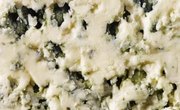
Mold can grow on many things including food. For instance, you may see mold grow on bread. It may look black, green, blue, yellow or another color. It may also have a fuzzy appearance. Mold is a type of fungi, so its spores are frequently in the air. Bread provides an inviting home for the mold spores.
TL;DR (Too Long; Didn't Read)
Mold grows on bread because spores land on it and begin to multiply. It can grow quickly on bread and start a colony.
The World of the Mold Spore
Mold spores are microscopic plants that float on every breeze, inhabit every inch of earth and surround us everywhere we go. Some molds produce mycotoxins, which are dangerous poisons that can cause serious illness. Other molds are beneficial, breaking down diseased yard waste and providing building blocks for antibiotics, miracle drugs that have saved millions of lives. Molds helped scientists break the genetic code and today help researchers discover the effects of humanity's "biological clock" and how it works. One of the most familiar forms of this filamentous fungus is the fuzzy green and gray growth that affects the foods we keep, particularly breads.
The Birth of a Colony
Once a spore finds a piece of bread in a dark, cool place where air does not circulate well, it sinks its little feet, called "hyphae," into the spaces that make up the surface of bread. Mold spreads rapidly, forming the mycelium or mold colony. Clusters of hyphae, called "sporangiophores," grow upward, forming the mature "conidia" that hold the spores and give each mold its distinctive color. When their cases break open, tiny spores go airborne until they find a hospitable place to land that is cool, damp, dark and has a good food supply, and then the process begins anew. The hyphae dig deep into the porous surface of the bread, working through it as well as over its surface.
Looking for a Home
Mold spores are the "seeds" cast off by mature fungi. They are everywhere, but they need the right environment to settle and grow. Aspergillus, Penicillium, Rhizopus and Neurospora crassa are a few of the thousands of mold spores that float around the kitchen looking for places to start colonies. Bread, particularly white bread, is an attractive place to land because it is high in starch, a substance that breaks down into sugars, which is a high-energy food for mold. Bread is also generally kept sealed in a bag, limiting air circulation and stays in a cool, damp, dark place like a refrigerator or bread box. These are prime conditions for development of mold colonies.
If the temperature is too cold, like in the freezer, the little spores will not be able to grow and will shrivel up. Mold cannot survive at high temperatures either, making baking a good way of destroying mold. Once the starches in bread begin to "set up," however, it becomes a tempting treat for hungry mold spores. Because molds do not have chlorophyll like other plants, they are particularly aggressive feeders, so thousands of spores can cover a piece of bread overnight and millions in a few days.
References
About the Author
An avid perennial gardener and old house owner, Laura Reynolds has had careers in teaching and juvenile justice. A retired municipal judgem Reynolds holds a degree in communications from Northern Illinois University. Her six children and stepchildren served as subjects of editorials during her tenure as a local newspaper editor.
